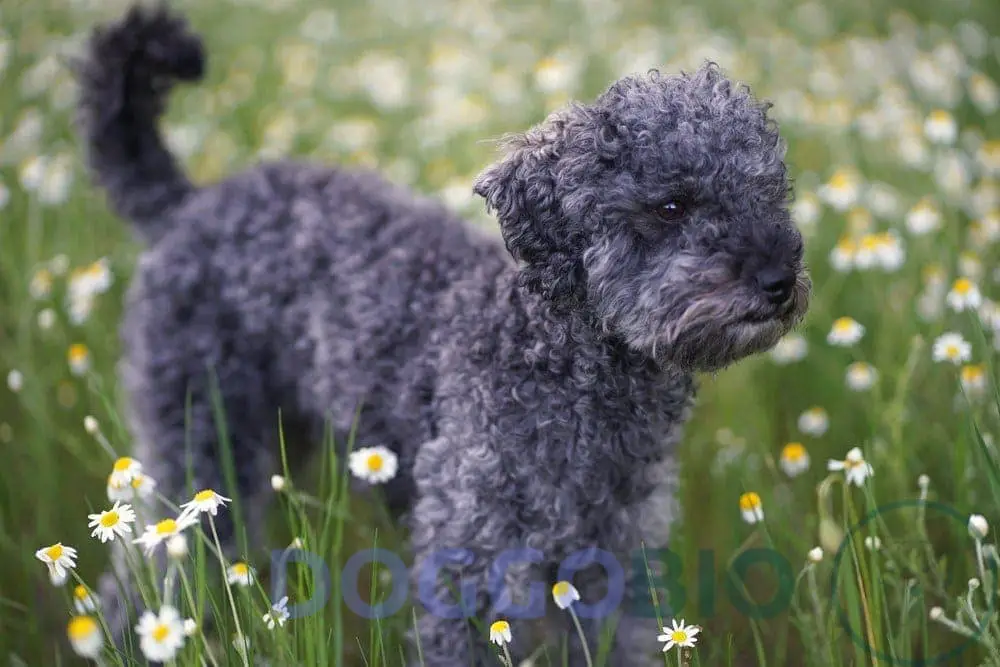The Blue Poodle is a unique and stunning dog breed that is highly sought after by dog lovers worldwide. With their distinctive curly blue coat and intelligent, friendly nature, they make excellent family pets and companions.
This breed is known for its elegance, agility, and playful temperament. They are highly trainable and enjoy being around their owners. Bred initially in France, the Blue Poodle has become famous for those looking for a beautiful and affectionate dog. Whether you’re an experienced dog owner or a first-time pet parent, they are lovely addition to any household.
What is a Blue Poodle?

Blue Poodles have sparked intrigue in dog breeding circles. Yet, the term “blue” is misleading. In reality, there’s no such thing as a blue Poodle.
What we see as blue Poodles are actually black Poodles with fading coats. This “graying out” is due to a genetic mutation affecting melanin production. However, this doesn’t occur in light-coated breeds like white or cream Poodles.
Is a Blue Poodle different from Black Poodle?
Yes, Blue Poodles are different from Black Poodles.
The primary distinction is their coat color. Black Poodles sports a rich black hue, whereas Blue Poodles have a steel blue shade due to a genetic mutation altering the black pigment. As they age, blue Poodles’ color can fade, while black Poodles retain their deep black shade. Blue-eyed blue Poodles might indicate health concerns, while brown-eyed black Poodles are typical and generally healthy.
In terms of temperament, both are smart and lively. Some believe blue Poodles can be shyer, but this varies by individual. Despite these differences, both types are wonderful companions for Poodle enthusiasts.
Do the Blue Poodles change colors when they grow older?
Yes, Blue Poodles can change colors as they age.
Poodles are renowned for their coat color transformations. Some can shift from white to darker shades, while others start dark and lighten. Typically, a Poodle’s coat stabilizes in color by three years old. However, certain Poodles “hold” their initial color throughout their lives.
Why does the Poodle’s fur turn gray?
Well, there are a few reasons.
- Firstly, aging Poodles can experience age-related greying.
- Secondly, Poodles can have a grey or silver gene that changes their coat color.
- Now, when it comes to the grey or silver gene, it can behave differently. Sometimes it doesn’t entirely dominate in black Poodles, giving them a slate grey or blue coat. But when it is thoroughly dominant, it can result in the Poodle showing grey hair in specific areas or turning completely silver.
So, don’t worry if your Poodle starts to turn grey as it ages – it’s a natural part of the aging process, and your Poodle will still be as lovable and loyal as ever.
What Does a Blue Poodle Look Like?

Size, height, and weight
They can come in various sizes, leaving you scratching your head. Here are the four measures you might encounter:
| Breed | Size Group | Height (inches) | Weight (pounds) |
| Standard Poodle | Medium-large | 18-24 | 44-71 |
| Medium Poodle | Medium | 14-18 | 33-42 |
| Miniature Poodle | Small | 11-14 | 26-31 |
| Toy Poodle | Small | 9-11 | 14-17 |
Coat colors and types
The striking blue Poodle is undoubtedly a fan favorite, but did you know that there are 11 other shades that these furry friends come in?
From the classic true black and silver to the unique apricot and cafe au lait, the Poodle coat color spectrum is diverse. Moreover, the rare silver beige and particolored Poodle will leave you in awe.
Temperament and Personality
Blue Poodles can be quite the handful with their boundless energy and playful nature. But watch out, they also have a knack for being great guard dogs, always on high alert. Their loyalty and eagerness make them stand out, and they tend to believe they are the center of attention.
Training

They require a balance of sternness and kindness during training sessions. They are brilliant and desire to please their owner, making training relatively simple.
However, it’s essential to be mindful of showering them with too much affection, as it can be easy to go overboard with petting and attention.
Exercise Requirements
Blue Poodles are known to be quite lively and active, and they love running and playing. Though they don’t require excessive exercise, they tend to be the happiest when involved in some physical activity.
If your canine is not provided with enough exercise, it may develop behavioral problems and obesity, leading to other health issues. Therefore, keeping your dog engaged in physical activities and providing enough opportunities to burn off their energy is crucial.
Grooming and Cleaning
Blue Poodles demand high grooming and cleaning to maintain their impressive looks.
- Keeping their coat in prime condition requires regular brushing with either a pin or slicker brush. In addition to this, they should get a trim once every six weeks. This is essential to keep their hair at an acceptable length and prevent it from becoming a hygiene issue.
- Their ears can be a particular concern. They should be trimmed regularly to prevent a buildup of wax, dirt, and moisture that can lead to infections.
If you aim to show your Poodle, you should take them to a professional pet salon. They can groom your Poodle to perfection, making them ready to take on any beauty pageant.
Are a Blue Poodle Hypoallergenic?
Yes, Blue Poodles are hypoallergenic. Poodles are an ideal choice for those with pet allergies due to their hypoallergenic coats.
The primary culprits of pet allergies are dander, saliva, and urine. Poodles, with their single coats, shed less, leading to reduced dander. Their dense hair also traps loose hairs, further minimizing shedding.
While Poodles can still produce allergens, their coats are generally more suitable for allergy sufferers compared to other breeds. So, for a hypoallergenic pet, Poodles are a top pick!
Food and Diet
Blue Poodles need a diet high in protein to help maintain their energy levels and promote muscle growth. But that’s not all! They also require vitamins and minerals to keep their coat shiny and healthy.
Regarding the quantity of food, it’s essential to keep in mind the size and activity level of your dog. An active dog will need more food than a couch potato Poodle.
But here’s the kicker: Overfeeding your Poodle can lead to obesity, which can cause significant health issues like joint problems and diabetes.
So, it’s crucial to consult a vet or a professional dog feeder for advice on the correct quantity and type of food to feed your Poo. Please don’t skimp on your pup’s diet; it’s the key to a happy and healthy life!
Common Health Issues
Blue Poodles may be a healthy breed, but like all dogs, they are not immune to specific health problems.

1. Demodectic mange
Demodectic mange is a parasitic condition caused by Demodex mites in the dog’s skin. The mites usually live harmlessly on the dog’s skin but may cause itchy and inflamed skin in allergic dogs.
Demodectic mange can lead to hair loss and is more common in young dogs and those with weakened immune systems.
2. Allergies
Believe it or not, Poodles, can suffer from allergies like humans. But unlike us, they can’t tell us what’s bothering them. Some signs of allergies in Poodles include inflamed skin, excessive scratching, and patchy hair loss.
3. Skin condition
Sebaceous Adenitis is a rare skin condition that affects Poodles, among other breeds. The disease occurs when the sebaceous gland, which produces an oily substance to keep fur healthy, becomes inflamed and enlarged. The gland produces less oil, leading to dry and brittle skin and hair loss.
4. Cushing’s disease
Cushing’s disease is a complex medical disorder that involves the overproduction of cortisol – an essential hormone that affects various body functions such as metabolism, stress response, and the immune system.
This condition can lead to severe health problems such as diabetes, excessive thirst, frequent urination, and hair loss. Identifying Cushing’s disease early is crucial for effective treatment and management of symptoms.
Symptoms of Cushing’s disease can include lethargy, increased appetite, weight gain, and a pot-bellied appearance. If your Poodle exhibits any of these symptoms, it’s crucial to contact your veterinarian immediately.
5. Gastric dilation-volvulus (GDV)
Bloat, also known as gastric dilation-volvulus (GDV), is a severe condition that affects many dog breeds. It happens when the pup eats too fast or too much, causing its stomach and intestines to expand rapidly, resulting in a dangerous rise in internal pressure.
This can be fatal if not treated promptly, so you must seek veterinary care immediately if you suspect your puppy is experiencing bloat.
How Long Does a Blue Poodle Live?
Like other breeds, Blue Poodles have a lifespan that depends on various factors. Generally speaking, Blue Poodles bred by reputable breeders and receiving proper care can expect to live anywhere from 10 to 18 years.
However, many variables, including genetics, diet, exercise, and medical care, can impact their lifespan. It’s essential to remember that while some they may live longer than others, each dog is unique, and their lifespan can vary.
How Much is The Price of a Blue Poodle?
Blue Poodles are relatively inexpensive compared to other breeds, and you can get your furry friend for as little as $500.
However, the cost of a Blue Poodle depends on various factors, such as parentage, age, health, and size. If you are looking for a top-quality Blue Poodle with a pedigree, the price can go up to $2,000.
It’s essential to do your research before buying a Blue Poodle and make sure you’re not getting scammed. Always buy from reputable breeders who care for their dogs and can provide you with health certificates and other necessary documentation.
Is Blue Poodle Right For Me?
The Blue Poodle, with its stunning appearance, adores being around you and can learn several tricks due to its high intelligence.
However, this furry friend comes with a catch – its grooming demands are pretty high. Therefore, the Blue Poodle could be the perfect match if you are willing to dedicate your time and resources to meet those demands.
List of dogs that are similar to Blue Poodle
Frequently Asked Questions
1. Does Blue Poodle get along with other pets?
Yes, Blue Poodles generally get along with other pets, but it can vary. While Blue Poodles are fiercely loyal to their owners, their interactions with other animals can differ.
Typically, they bond well with other dogs and can even become close pals. However, their compatibility with other pets largely hinges on their upbringing. If brought up in a household with multiple pets, they’re more likely to be amicable.
Early socialization and training play crucial roles in ensuring harmonious relationships between Blue Poodles and other animals.
2. Are the Blue Poodles rare?
Yes, Blue Poodles are rare.
Their rarity has driven up their cost. However, other unique Poodle coat colors like red Poodle, Cafe au Lait, sable, and apricot can be even pricier due to their distinctiveness.
3. What are the rarest colors of Blue Poodles?
Look no further than the elusive apricot Poodle. As a result of a recessive gene, these furry creatures are as rare as they come. Their coat color is a delicate blend of light red and cream that will catch your eye.
4. Can Poodles have blue eyes?
Yes, Poodles can have blue eyes.
However, according to the American Kennel Club (AKC), blue eyes in Poodles are not a sought-after trait. It’s often seen as a sign of potential health issues, especially in senior dogs.
5.What is a Blue Moyen Poodle?
A Blue Moyen Poodle is a Moyen Poodle that has a blue-colored coat. Depending on the dog’s genetics, this blue color can be achieved in different shades and patterns.
Conclusion
In conclusion, the Blue Poodle is a remarkable dog breed that combines beauty and intelligence. Their striking blue coat, friendly personality, and high trainability make them popular among dog enthusiasts. They are loyal companions who enjoy spending time with their owners and thrive in a loving and nurturing environment.
As with any breed, it is essential to do thorough research before committing to bringing a Blue Poodle into your home. With proper care, training, and socialization, the Blue Poodle can make an excellent and beloved family member.

Pingback: Phantom Poodle: Diving into the World of Unique Coat 2023
Pingback: Parti Poodle: Dive into the World of this Breed 2023
Pingback: Merle Poodles: Interesting Facts You Need to Be Aware of 2023
Pingback: Red Poodle: Delve into the Fantastic World of This Breed 2023
Your writing style is incredibly engaging. I felt like I was on a journey through the topic. Fantastic post!